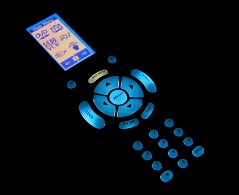|
...Continued from Page 1.
Batteries & Charging
Due to its high power draw, the folks at RTI wisely chose to go with rechargeable batteries rather than alkaline AA’s. The NiMH battery pack attaches firmly to the rear of the remote and maintains the same physical profile. There are no provisions for the battery to charge while in the remote. Instead, a separate compact desktop charger is installed that can either sit comfortably on a table or be permanently wall mounted. A single light informs the user of what is happening: if it is blinking, the battery is charging. If solid, it is complete and ready to use. Smart charging circuitry shuts off the charging process when it is complete, preventing overcharging.

Batteries & charger.
Click to enlarge. (32kb)
|
Since the battery must be removed from the remote to recharge, RTI actually includes two NiMH packs in the base package. Though our sample remote came with battery capacities of 750mAH, the final shipping product will include 900mAH providing a continuous runtime of around eight hours, or thirty days on standby. When the batteries are low a small icon appears in the top left of the LCD; when they get really low a full-screen message appears. One great feature of the T2 is that it does not need to boot up – pop the battery in and it’s ready to roll. Non-volatile memory keeps your custom program safe without any power.
So, what’s all that power used for?
Blue, White & Bright All Over
Fantastic backlighting! Twenty-five user buttons are lit with a vibrant blue electrolumanescent (EL) panel, while the "Main Menu" button and LCD panel are lit with paper-white. All EL panels require circuitry that boost battery voltage, and it is that circuitry which creates a soft buzzing sound you may have heard on watches, handheld PCs or other remote controls. It seems the brighter the backlight, the noisier the circuitry. Pleasantly, despite the TheaterTouch’s remarkable lighting the noise level is no greater than other comparable remotes, and even manages to be quieter than some. The screen can be enabled by tapping it or pressing any button, or by using the built-in tilt sensor which activates the screen whenever it is tilted past a 45 degree angle. Additionally, you can configure it so the LCD only turns on when it is tapped or the backlight button is pressed – thereby saving battery power when merely changing channels or adjusting the volume.

Backlighting in the dark.
Click to enlarge. (33kb)
|
At the very top of the remote is a well-placed touchscreen LCD that easily rates as the best I’ve seen in terms of contrast and clarity. The bright white lighting and stunning blue LCD is crisp and clear under any lighting condition, including direct light. In the dark, the remote is a blazing beacon of welcoming control. Unfortunately the clear screen comes at a price. First, the entire LCD window provides only 2.9 square inches of visible space, with only 2.3 of that actually occupied by LCD elements. Finally, the visible resolution is limited to 64x128 pixels with two colors – black (or in this case blue) and white. That’s not to say the screen isn’t useful – far from it. The default text and simple icon user interface is clean and easy to read; the limitations come only when you wish to create custom bitmaps or buttons, as will be described later in this review.
| 
